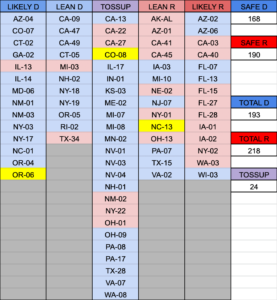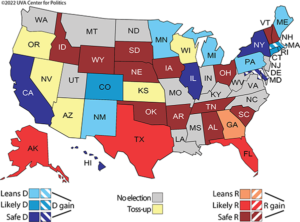From “Red wave hits breaker: GOP midterm worries rise” by Emily Brooks at The Hill: “Republican worries of a midterm flop are growing heading into the critical post-Labor Day campaign season, with analysts who had previously predicted massive GOP gains shifting their forecasts toward Democrats….Rick Tyler, a Republican strategist and analyst, said the environment looks “not even close” to a red wave election year….“The enthusiasm is just not there,” Tyler said. “Last time Republicans had a good year, they were 6 points ahead in the generic poll. Now we’re barely 2 points ahead. So it’s definitely not going to happen.”….RealClearPolitics averages of pollsmeasuring whether voters would prefer Republican or Democratic control of Congress show the GOP advantage slipping from 4.8 points in late April to less than a point as of Friday. At around this point in 2010, when Republicans saw historic gains in Congress, generic polls showed an advantage of 4 to 6 points for the GOP….Weaknesses for GOP candidates along with results from recent elections have led election analysts at Sabato’s Crystal Ball at the University of Virginia Center for Politics and The Cook Political Report to shift several forecasts for key congressional midterm races toward Democrats. Cook revised its expected GOP gain in the House from 15 to 30 seats to 10 to 20 seats, and its Senate outlook from Republicans having an edge to a toss-up….Kyle Kondik, managing editor at Sabato’s Crystal Ball, said that weaknesses in GOP Senate and gubernatorial candidates, as well as many Republicans’ position against abortion, has given Democrats the opportunity ”to make the election more of a choice than a referendum.” But he cautioned against fully reevaluating the midterm environment before Labor Day and said that Republicans could still flip both chambers even if they fall below expectations of a “red wave.”….“It is possible that the Democrats’ addition of more college-educated voters, at the expense of losing more non-college voters, has skewed some of these special elections, as the college cohort is a more reliable voting bloc,” Kondik said. “That said, if the GOP had some big enthusiasm edge over the Democrats — and if it was bringing a lot of lapsed GOP voters back into the fold — one would think they’d be doing better than they are.”
In “Ratings Update: Democrats Gain Big in House Races” at Elections Daily, Eric Cunningham writes: “The national climate has undeniably shifted, perhaps from a Republican wave to a so-called “ripple” or neutral environment. We regard Republicans as the unequivocal favorites to hold the House, still, but our ratings changes predominantly benefit Democrats. The vast majority of our changes here are shifting potential upset races or fringe races we considered to be on the table. Additionally, we’re moving a handful of urban or suburban-oriented Republican seats back onto the board….Currently, we favor Republicans in 218 seats (the absolute bare-minimum for a majority) and Democrats in 193. We have 24 seats rated in the Tossup column….”

Amy Walter observes at The Cook Political Report that “Democrats are getting help flipping the script thanks to the Supreme Court and Trump. For the first time in history, warnings by Democrats about a rollback of abortion rights aren’t theoretical. Poll after poll continues to show that the Supreme Court’s decision to overturn Roe v. Wade is widely unpopular. And, as my colleague David Wasserman has noted, Democratic engagement in the post-Dobbs era has jumped considerably. In the four special elections since the June 28th Supreme Court decision, Democrats have outperformed 2020 results by as many as 6 points….Then, there’s Trump. While Youngkin was able to keep the polarizing former president at arm’s length, most of the other high-profile Senate candidates are embracing him. For the last few weeks, Trump and his ungrounded claims of voter fraud have dominated the political and media discourse. July has been dominated by coverage of January 6th commission hearings, the primary defeat of the committee’s GOP chairwoman Liz Cheney, the FBI discovery of classified documents at Mar-a-Lago, and Trump’s ongoing legal troubles in Fulton County, Georgia. The party out of power — rather than the in-party — is in the spotlight….The more Trump is in the news, the more dangerous the political climate for the GOP….While neither Biden nor Trump are popular, Trump is the more polarizing. New polling from NBC News finds Trump’s net favorable ratings (-18) to be twice as bad as Biden’s (-8). That same dynamic is showing up in swing states like Arizona, where a recent FOX News poll finds Trump’s net favorable at -20 to Biden’s -10, and Wisconsin, where the FOX poll showed Biden’s net favorable ratings at (-6) compared with Trump’s (-10)….Democrats, especially incumbent Senators in key swing states, have built up solid foundation for themselves. Polling in Senate races not only finds Democrats leading in the ballot test, but also holding strong favorable ratings, especially among independent voters….A big reason for that bump in popularity is that Democratic incumbents have had the airwaves to themselves for most of the last two years. Since the beginning of 2021, significantly more money has been spent on positive ads for Democratic Senators in Arizona, Georgia, New Hampshire and Nevada than on negative ads against them….According to information provided to the Cook Political Report by AdImpact, every one of those Senators has had at least a two-to-one advantage on the airwaves.”
Gabrielle Gurley’s “Democrats in Danger of Missing the Marijuana Moment” at The American Prospect spotlights a danger — and an opportunity — for Democrats. As Gurley writes, “The Supreme Court’s revocation of abortion rights and the rush of red states to ban it altogether have opened the eyes of young voters to the perils of sideline-sitting at election time. President Biden’s decision to forgive $10,000 of student loan debt may also energize more young people to vote in the midterm elections. But failure to deliver on a slam-dunk issue like the federal decriminalization of marijuana could convince other voters to skip the general election….Removing research restrictions is a monumental step, but what voters across the political spectrum, and especially people under 25, are waiting for is the end of prohibition. The Cannabis Administration and Opportunity Act (CAOA) offers that pathway. The mammoth federal regulatory proposal, introduced in July by Senate Majority Leader Chuck Schumer and Sens. Cory Booker of New Jersey and Ron Wyden of Oregon, would end the federal prohibition of marijuana and remove cannabis from the Controlled Substances Act….Currently, recreational marijuana is legal in 19 states and medical marijuana in 39. An astonishing majority of Americans agree that marijuana should be legal for medical or recreational purposes. A July Gallup poll found that more than 50 percent of people 18 to 34 regularly use some type of marijuana product. Legalization is popular with young people, but it depends on who you ask: Americans ages 25 to 29 support legal cannabis by a 50 percent to 28 percent margin, with 21 percent unsure. Among people 18 to 24, the figure drops to 38 percent, with 39 percent opposed and 22 percent unsure. (On abortion and student debt relief, young people are much more uniformly aligned: 78 percent of young people support legal abortion, while 85 percent support some type of student loan debt relief.)….Cannabis descheduling by Congress or by a presidential executive order might serve as a motivational lever for both young potential voters and other unmotivated ones, demonstrating what they can expect next year if Democrats remain in power—or what they can expect if the Republicans take one or both houses of Congress.”




